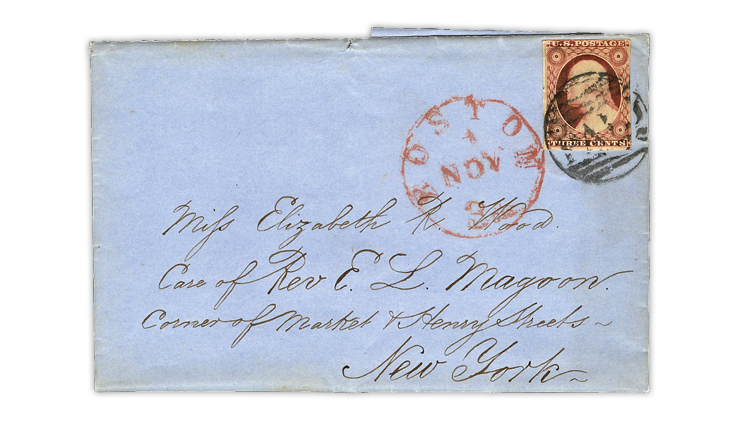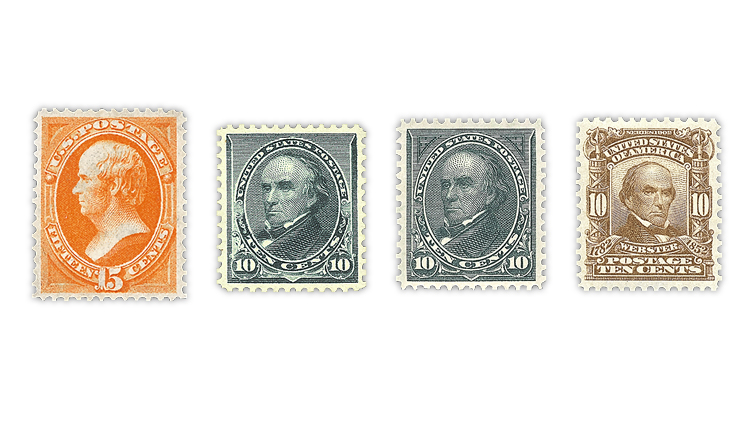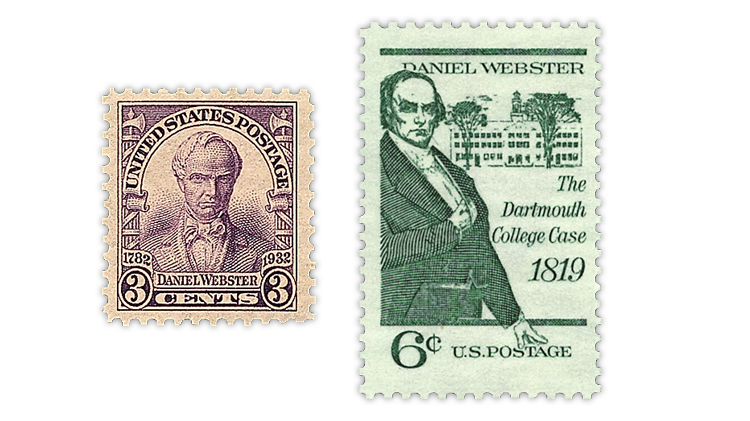US Stamps
Daniel Webster honored in letter and on postage stamps
U.S. Stamp Notes by John M. Hotchner
Contemporary reports of historical events are a nice surprise when a letter is found inside an old cover. However, this happens infrequently. But with a folded letter you are guaranteed a letter. Before the use of the envelope became commonplace, letters were folded, addressed and mailed without one.
There were some envelopes prior to 1845, but they were all handmade. In that year, a patent was granted for a steam-driven machine that could produce envelopes in quantity.
Envelopes rapidly became popular as a medium for sending messages, but they didn’t completely replace folded letters for many years.
Figure 1 shows a folded letter sent from Boston to New York, franked with a type II imperforate 1851 3¢ Washington (Scott 11A). The letter inside is dated “Sunday afternoon, Oct. 31, 1852.”
The letter, sent from a brother to his sister, concerns family matters but also mentions his last letter in which he wrote of “the intended obsequies of the lamented Statesman which were to take place on the succeeding Friday at Marshfield, Mass.”
Marshfield is the final resting place of Daniel Webster (1782-1852), the “Statesman” referred to in the letter. Webster had died on Oct. 24, and there was much mourning in the Northern states where he was especially popular.
Webster began his public career in Congress as a representative from New Hampshire from 1813-17, and as a representative from Massachusetts from 1823-27.
In 1827 he was elected to the United States Senate, where he served until 1841, and then again from 1845 until 1850. In 1830 he delivered one of his best-known speeches, in which he ended with “Liberty and Union, now and forever, one and inseparable!” That phrase was later engraved on the Daniel Webster memorial in Washington, D.C.
From 1841 until 1843 and again from 1850-1852, he served as secretary of state. He ran unsuccessfully for president in 1836, 1848 and 1852.
One of the great orators of his time, he was a powerful advocate for preserving the Union and avoiding the Civil War. In 1957, a Senate committee selected Webster as one of the five greatest U.S. senators of all time, along with Henry Clay, John C. Calhoun, Robert A. LaFollette Sr., and Robert A. Taft.
Three of these men have been honored on U.S. stamps, but Calhoun — a defender of slavery and Southern interests — and LaFollette have not.
Webster was first recognized on the 15¢ orange stamp in the 1870-71 issue (Scott 141). He remained on a current U.S. stamp for the next 35 years (152, 163, 174, 189, 199, 226, 258, 273, 282C, 283 and 307). Four of these Webster definitive stamps are pictured in Figure 2.
He was again honored in 1932 and 1969, and Figure 3 shows these 3¢ and 6¢ commemoratives (Scott 725, 1380).
Now I will return to the 1852 letter. The writer, after referring to his earlier letter, continues: “Accordingly, at sunrise I was awakened by the booming of cannon, and the mournful tolling of the bells, which in themselves told the tale of woe. The stores were mostly closed and a great number of assembled at the railroad stations and Steamboats eagerly awaiting the hour of departure.
“The particulars of the funeral you have probably seen in the daily papers, so I will not occupy my limited space with another recital. Suffice it to say that no man but Daniel Webster could have commanded to such a degree, the respect and admiration of all parties.”
Connect with Linn’s Stamp News:
Sign up for our newsletter
Like us on Facebook
Follow us on Twitter
MORE RELATED ARTICLES
Headlines
-
World Stamps
Oct 8, 2024, 3 PMRoyal Mail’s Oct. 1 definitive meets new international standard rate
-
World Stamps
Oct 8, 2024, 12 PMPostcrossing meetup Oct. 9 at U.N. headquarters
-
Postal Updates
Oct 7, 2024, 5 PMUSPS plans to raise postal rates five times in next three years
-
US Stamps
Oct 7, 2024, 3 PMMcMurtrie dismissed as APS education director following Sept. 21 arrest











